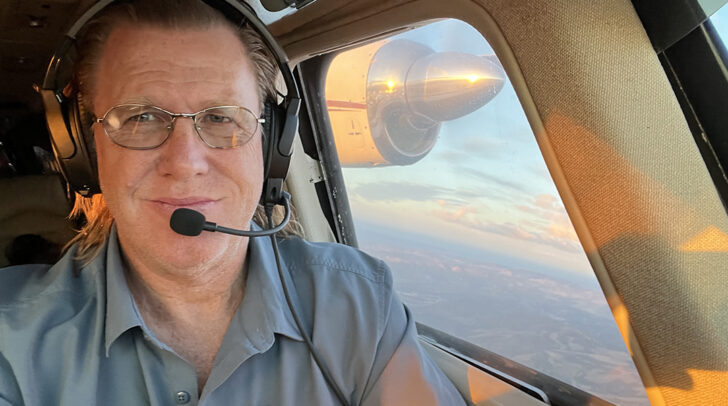
Dale Head’s path to successful business owner was long and winding. Competing in the feast-or-famine world of air attack isn’t easy for anyone, but newcomers must be especially lucky to survive. And although Head’s success comes down to perseverance, fate has given him a hand along the way.
Like many pilots, Head knew he wanted to fly since he was a kid. As his family watched the Saturn V lift off the pad on TV, he explained what was happening to his mother. But lackluster grades in school meant no flight school, so he became a firefighter instead. After retiring and building a house, he was standing on the new deck with an inspector and they started talking about aerial tankers. The inspector made a radio call and soon, overhead, Head saw his future. “I wanted to fly air attack,” he said.
In 2003 he began flight training, and he started with the airlines in 2006. In 2009 he got his first job in the industry, flying right seat in a P-3. After that job went away, he spent a stint flying ISR in Afghanistan, and then took a massive pay cut to get back into the business, flying a ratted-out Cessna 337 in Washington. He lived in a camper at the airport to make it work.
Finally, in 2014, he made his way into a Twin Commander and the coveted air attack role flying for Courtney Aviation. But it was a later job flying for another company that convinced him he could do it better.
In 2019 he started MindWinder Aviation at the Reno Stead Airport in Nevada with a single Twin Commander 690C with Dash 10 engines. It took about 18 months to get the Part 135 certificate from the FAA, and then a stroke of luck led to almost an immediate contract with the U.S. Forestry Service. Head said that another company was having a hard time meeting its obligations with the USFS, and only two months after receiving the charter certificate they were on assignment.
Air attack contracts are either exclusive-use, where assets are stationed at all times strategically around the country for a rapid response. Or they’re on demand, and called only when the need exceeds the exclusive-use capacity. MindWinder has been active each of the company’s first three seasons. They have been growing slowly every year, adding a second leased 690C with Dash 10 engines, a Citation, and a Beechcraft Baron for logistical support.
This year the team clocked 160 hours on each of the Commanders between June 30 and September 25, when their season ended. They can work from the Canadian border to the Mexican border, and have helped coordinate the fire response in most of the Western states.
When Head started the company, he went looking for a Twin Commander because of the airplane’s versatility. “They have a great visual down to the fire, they are powerful, and comfortable,” he said. His first experience with the Dash 10 upgrade was while flying for the state of Nevada, and he said it was the best Commander he had flown. With extended fuel and more power, they can do things other airplanes can’t. “Our standard mission is four hours over the fire,” he said. “We block six hours, and have done 5.8 in the air. Plus, I can be refueled and out in 20 minutes.”

In addition to four FM and four AM radios for the fire supervisor, both of the company’s Commanders also have side-looking infrared radar, which serves both a practical and tactical purpose. Practically it helps the pilot map the fire and terrain when turning to the right, since visibility is limited by the right seater. They’ve also come to rely on it as a tactical tool. On a recent fire they received a report of new flare-ups on the ground. Flying over to investigate they didn’t see smoke, and considered calling it a false alarm, but the IR picked up a hot section of the forest. That enabled ground assets to take care of it long before it grew to become a big problem.
The company does its own maintenance, headed by Miles Anderson, a young technician with a master’s degree from Embry-Riddle Aeronautical University and a passion for professional maintenance management. He was recently named a 40 Under 40 by Aircraft Maintenance Technology magazine. Even with such a small operation, they try to be nimble. This year, for example, they changed an engine in the field and were back up and running in just a few days.

Head is able to attract good talent in part because a primary motivation for starting MindWinder was to offer a better quality of life for the staff. When he started flying the P-3, the pilots got one day off a week during the season, meaning not enough time to get home. At MindWinder, pilots are given the opportunity to take days off during the season to take care of business at home, or just rest and rejuvenate. “I determined I wanted to create an environment of respect and where people can have a life and I could provide a good income with that,” he said.
For Head, rejuvenating means playing music. He’s spent many years performing all over the country as part of big band and jazz ensembles, both singing and playing trumpet. While he’s on the road he brings his trumpet and a portable speaker and jams on the ramp to keep his chops up. It’s also a way to make friends on the road because he can join local sessions.
More than the incredible air attack flying experiences, he’s regained that feeling of a shared sense of purpose. “That’s what I missed from being a city firefighter; people pulling together and doing a mission and serving something bigger than themselves.”
